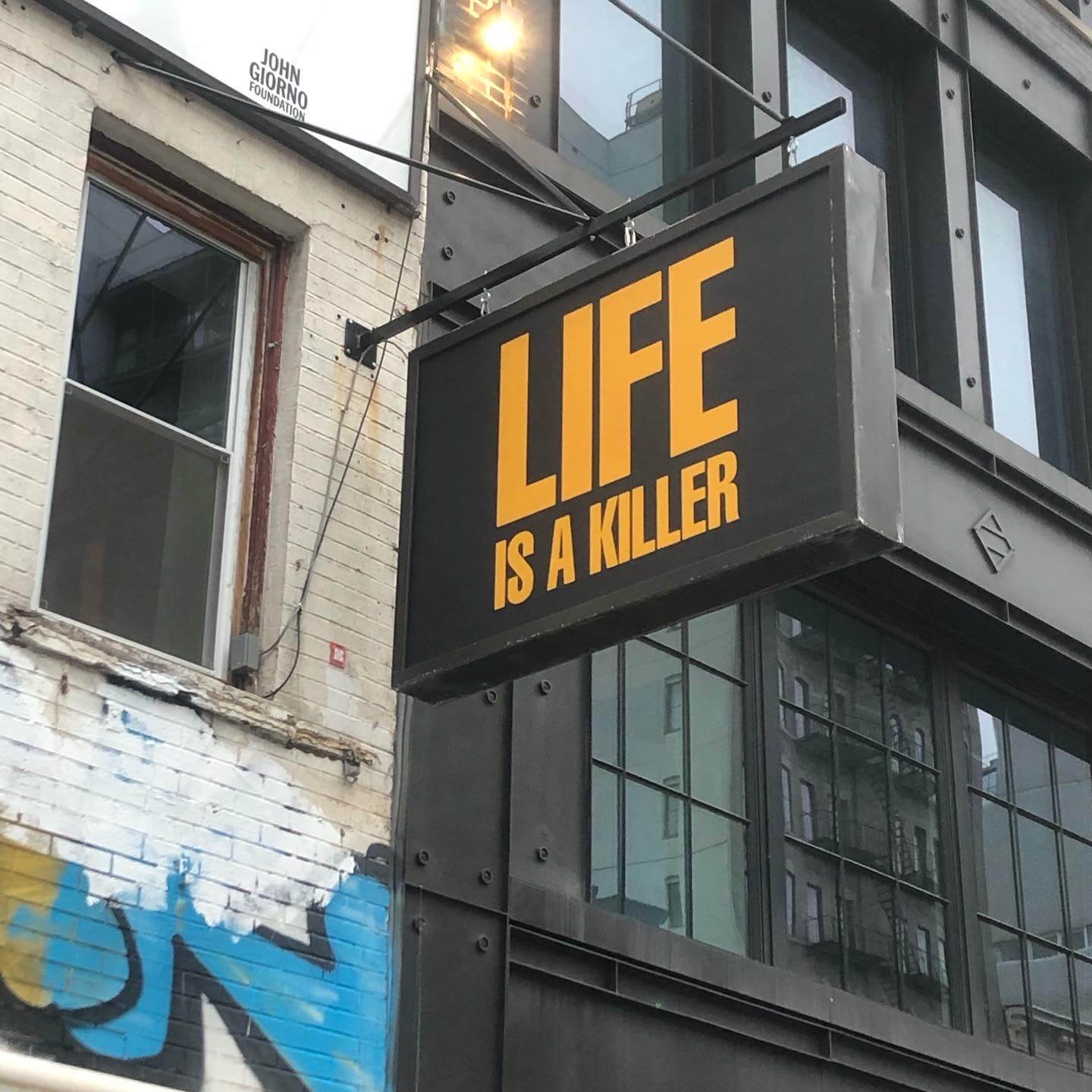I was off to The Bunker.
The storied home of William S. Burroughs. Where he lived on The Bowery.
Downstairs from Giorno’s apartment.
The Bunker is now home to The Giorno Foundation.
I was running a little late the train from Brooklyn was delayed.
I skated from the train as fast as I could.
Avoiding a smashed beer can. Pedestrians. A turning cab. As fast as I cold push up The Bowery.
I had lived at 373 Bowery so I made my way past the old Audio Visual store, the old bank with large concrete lions, now an event space where Grammy and Oscar after parties are held.
Through the evening traffic I pushed up the Bowery to number 222.
I was looking for the door through the iron gate out front.
There was a partially open door and a young strawberry blonde woman.
I said is this the John Giorno Foundation?
“Yes it is she said – push the door”
I did. At first nothing…
Then it slowly opened.
I asked about the film screening.
The Giorno foundation was recently opened and hosts events to allow the public into The Bunker, William Burroughs and John Giorno’s home.
I had seen the documentary a number of times it had its moments and great footage of William reading and discussing his life.
But I was here to see the Bunker itself. Curious about the fabled space.
Here William wrote, shot pistols for target practice, and entertained guests from Allen Ginsberg, to Patti Smith, Basquiat, and many many more.
The girl and I discussed the SOLD OUT event until an older woman came down the stairs.
“We can hear every word you are saying!” She said angrily.
I couldn’t help but laugh.
Then she said “just let him in!”
So I walked up the steps carrying my skateboard.
I waked into the dark room lit by the film screen as the film had already started. She pointed to the second row right in front.
Go sit there – she gestured toward the empty chair.
I made my way carefully through the people and sat on the folding chair.
Slid my board under my chair.
I was in!
Soon there was Willam in his characteristic hat and suit on screen.
Later a look in on a surgery by Dr. Benway.
“All in a days work” he says sending a nurse to fill his prescription.
As the film rolls I look about the room.
The Bunker — is right.
It’s thick gray slab concrete walls with massive concrete beams over steel reinforcing.
With only a few windows.
After the film I roam the space.
I stand in the bedroom.
There are several painting by Bill.
His hat hangs on the wall.
His phone sits on a bedside table.
An old blue velvet chaise lounge maybe the only frivolous or fancy thing here.
A small arrangement of objects in the window includes a McDonalds Golden Arches – changed to Marijuana and a statue head from Indonesia, and an embroidered patch with a gun on it.
One of Williams shotgun pieces with collages of Lemurs is framed across the room.
A three panel wooden screen juts out from the corner.
It is covered in collaged newspaper clipping, drawings, and photos.
Out the door I enter the kitchen which is simply made with plywood.
A sink and rangetop and long wood counter and cupboards.
A long dining table with orange vinyl covered wood chairs.
Several Keith Haring works and John Giorno’s “Life’s A Killer” print.
There is also a large Buddhist shrine. Incense burns lightly.
Ticking my nose.
I go to the bathroom.
This basement space was a YMCA or something before.
There are two urinals in the bathroom and two stalls.
I took a stall.
I realize I was pissing in William S. Burroughs toilet.
Then I pulled the chain on the old style toilet.
The water flushed.
All the finest conveniences.
I recall that in the film someone remarked “William would have made a great prisoner.”
Apparently he went out infrequently. Spending much of his time in his own mind. Writing…
I speak with a few people.
Take some pictures.
I enjoy a moment there. This is cool.
There also is a feeling a presence there.
I felt it immediately after sitting down.
In the film Burroughs acknowledges his friends have noticed a spirit or ghost there.
He says he calls it Tobi.
A woman from Belgium asks me about my skateboard.
Then takes a photo of it.
So I ask her to take a photo of me in The Bunker.
She does.
Then off into the night on The Bowery.
How many times I had passed this place and wondered about it.
It was a good visit.
A good night.
I skated south through Little Italy’s remnants and Chinatown’s light stringed streets.
Down to the subway back to Brooklyn.
Or maybe I will stop by a bar for a drink.
Blake Sandberg is a musician, artist and skateboarder who lives in Sunset Park. His band, Aliens, often plays in the area










